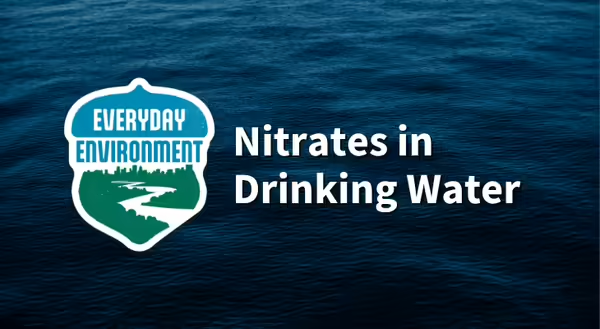
Nitrates in drinking water can be a concern in Illinois. In June, nitrate levels of 11.9 mg/L, higher than the federal standard of 10mg/L set by the U.S. Environmental Protection Agency, were discovered in the northern Illinois community of University Park, where bottled water is now being distributed. At low levels, nitrates are generally not harmful; however, elevated nitrate concentrations can pose health risks, particularly for infants.
What are nitrates?
Nitrates are naturally occurring compounds made of nitrogen and oxygen that easily dissolve in water. They are an important nutrient for plant growth and are commonly found in soil and fertilizers. Nitrates are also present in many foods, including vegetables and processed meats. High levels in drinking water can pose health risks for certain populations.
In Illinois, nitrates that enter the water supply can be from many potential sources, including fertilizer runoff from agriculture, golf courses, and lawns; leaching from septic systems; wastewater treatment discharges; and industrial pollution. These sources can affect both surface water and groundwater drinking water supplies.
Who is at risk for health impacts?
Infants: Infants, especially those under six months of age, are vulnerable to high nitrate levels. In the body, nitrate can convert to nitrite, which interferes with the blood’s ability to carry oxygen. This can lead to methemoglobinemia, also known as blue baby syndrome, a potentially life-threatening condition. Signs may include a bluish skin tone, unusual tiredness, or difficulty breathing. If you notice any of these symptoms, seek medical attention right away. To protect your baby’s health, never use water with elevated nitrate levels to prepare infant formula.
Other At-Risk Populations: Other populations may also be susceptible to health effects from elevated nitrate levels and may want to have conversations with their healthcare team. These include pregnant individuals and people with anemia, hereditary methemoglobinemia, reduced stomach acidity (such as people taking antacids), or those with weakened immune systems.
Important: Boiling does not remove nitrates. It can actually increase the concentration due to evaporation. Carbon filters, such as those used in countertop pitcher systems, also do not remove nitrates.
Water testing and treatment
Because nitrates are colorless, odorless, and tasteless, testing is the most reliable way to know if they are present in drinking water.
Public Water Supplies: Public water supplies in Illinois are regulated by the Illinois EPA, who require routine nitrate testing. If nitrate levels exceed the federal and state standard of 10 mg/L as N, alternative drinking water, such as bottled water, is provided. Treatment plant upgrades, such as ion exchange systems, are effective at removing nitrates, but installation and operation can be expensive. To view recent water quality results, check your utility’s water quality reports, known as Consumer Confidence Reports, through your local utility.
Private Wells: Private wells are not regulated by the Illinois EPA and are not subject to mandatory testing. It is the well owner’s responsibility to test the water for safety. Testing is recommended when the well is first constructed, annually, and after flooding or repairs. To arrange a nitrate test, contact your local health department or nearest Illinois Department of Public Health regional office. If your private water well has high nitrates, consult the Illinois EPA for information about water treatment options. For free educational resources on private well testing and maintenance, visit the Private Well Class website.
Actions you can take
- Test private well water as recommended, at least annually, when the well is new, or after flooding or repairs.
Use bottled water for drinking and cooking if nitrate levels exceed 10 mg/L as N, especially for babies, pregnant people, or those with certain health conditions.
Apply fertilizers carefully, following recommended application rates and timing to reduce the chance of runoff. For more information about agricultural conservation practices on Illinois Extension’s nutrient loss reduction website. Find best management practices for lawns on the Lawn the Lake website.
Maintain septic systems with regular inspections and pumping to prevent leaks.
Stay informed by checking your local water utility’s website about the public water supply or the Illinois EPA private well notices for private water wells.
References and Resources
Centers for Disease Control and Prevention: Guidelines for Testing Well Water | Drinking Water, ToxFAQs™ for Nitrate and Nitrite
Illinois Department of Public Health: Local Health Department Directory, Nitrates in Drinking Water, Private Well Testing
Illinois Environmental Protection Agency: Consumer Confidence Reports, Drinking Water, Private Well Users
Private Well Class: Free Online Education for Well Owners
U.S. Environmental Protection Agency: Frequently Asked Questions about Nitrate in Drinking Water, Nitrate-nitrite Fact Sheet
World Health Organization: Guidelines for Drinking Water Quality
Thank you for reading!
Everyday Environment is a series of blogs, podcasts, webinars and videos on exploring the intricate web of connections that tie us to the natural world.
Listen to the Podcast Sign Up for Everyday Environment Newsletter